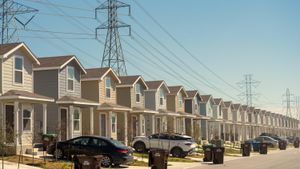A magnitude 4.4 earthquake rattled Grapevine, California, on August 8, 2024, marking the second day in a row the area has experienced this level of seismic activity. According to the United States Geological Survey (USGS), the quake struck at a depth of 11.8 kilometers, or roughly 7.3 miles, and was felt by many residents, eliciting 746 reports of tremors at the time of the incident.
This was not the first shake-up for Grapevine, as it followed another 4.4-magnitude earthquake recorded just the day before, which had its epicenter also located within the same city, this time at 11.3 kilometers, or about 7.02 miles, deep. The repetitive nature of these events has caught the attention of both locals and experts alike.
Interestingly, as California’s residents were bracing themselves for yet another quake, Japan was facing its own seismic turmoil. A 7.1-magnitude earthquake struck near Nichinan, Japan, on the same day as the Grapevine quakes. This earthquake was measured at a depth of 25 kilometers, or 15.5 miles, indicating the vast differences both geologically and geographically between regions experiencing seismic activities worldwide.
The USGS shared updates on their Twitter account, highlighting both incidents to keep the public informed. They provided interactive maps and additional insights, saying, "Notable quake, preliminary info: M 4.4 - 22 km NW of Grapevine, CA," emphasizing the significance of these occurrences.
Recent history has shown California is no stranger to earthquakes. Just last week, the region experienced another tremor, this one measuring 4.9-magnitude, centered near Barstow, California, at just over 7.3 kilometers deep. Reports indicated various states across the US had also felt their share of seismic shudders recently.
For example, earlier on July 29, the Los Angeles area reported this notable 4.9 shake, and it was preceded by another less powerful earthquake earlier on the same day, this one recorded at 4.5 magnitude, which shook parts of Utah. Though Utah isn't as widely known for earthquakes, it became notable recently as it was reported to have experienced 286 earthquakes last year, rating it ninth among U.S. states.
Interestingly, Maine too joined the scorecard for seismic disturbances with its own 2.8-magnitude quake deep within its grounds, centered around Gardiner on July 28. The USGS responded to multiple reports from residents who felt this smaller quake.
Seismology experts remind us natural disasters like these quakes can happen unexpectedly. The Maine earthquake, deemed relatively minor, was nonetheless significant since the state on average holds onto about one earthquake of magnitude 3.0 or higher annually and larger shocks only come along every 10 to 15 years.
Experts noted, as seen with the frequent seismic changes across various states, including Texas where two sizable earthquakes were reported only days prior, seismology isn't just confined to certain regions like California and is, instead, often spread across unexpected locales.
Texas previously witnessed tremors through Hermleigh, where two earthquakes measuring 4.9 and 5.0 magnitudes were registered later last month, not to forget the noteworthy 5.7 earthquake felt over Panama. These events serve as reminders of Earth's unpredictable nature and the need for constant preparedness against such phenomena.
This momentum of seismic events raises many questions about preparedness and emergency response protocols. Residents across affected areas are encouraged to stay informed about what to do before, during, and after earthquakes. They are advised to have emergency kits ready and plans established to account for possible evacuations or to navigate through damaged infrastructures.
The recent seismic activities have reminded many about the intricacies of living under potential earthquake hazards, particularly for those residing on the notoriously active Pacific Ring of Fire, where tectonic plates frequently interact, leading to earthquakes and volcanic eruptions.
California, often the poster child for quake readiness, emphasizes its building codes and earthquake preparation programs aimed at minimizing damage during such natural events. Nonetheless, it is the unpredictability of earthquakes—such as their occurrence with no clear warning—that continues to keep seismologists on their toes.
While scientists continue to study seismic trends and patterns, the unpredictable nature of earthquakes remains challenging. Historical data provide some insight, but predicting when and where earthquakes will strike next continues to defy even the most sophisticated science.
With more people moving to high-risk earthquake zones, there's growing concern about the ramifications should larger quakes strike populated cities. Scenario planning and risk assessments are currently hot topics among local governments hoping to bolster their disaster response plans.
Looking forward, there is hope technology will evolve to help improve detection and prediction of earthquakes. Innovations such as early warning systems aim to alert people moments before tremors strike. The technology, still under refinement, could provide invaluable seconds to mitigate danger and allow individuals to seek cover.
Regardless of advancements, residents need to remain vigilant. Earthquake safety protocols are the backbone of preparedness. Communities are advised to engage with local geological surveys and disaster management agencies to understand their risks better and to learn about the measures they can take to protect themselves.
Earthquakes can lead to devastating outcomes. From collapsed buildings to tremors rattling nerves, the significant impact of these geological events reminds populations near fault lines of their responsibility to stay ready and informed. Recent occurrences such as those reported from Grapevine and Japan highlight the importance of continual community education on earthquake safety.
The natural world often isn't predictable, and the case of Grapevine serves as yet another example. Residents and authorities must heed these calls to action. By fostering environments of awareness and preparedness, it might just save lives or mitigate disaster when the earth shifts beneath them. Indeed, as the seismic dice continue to roll, everyone's role remains pivotal.



